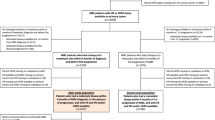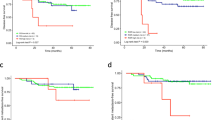Abstract
Background
Hormone receptor-positive and human epidermal growth factor receptor 2-positive (HR+/HER2+ breast cancer comprise approximately 5–10% of all invasive breast cancers. However, the lack of knowledge regarding the complexity of tumor heterogeneity in HR+/HER2+ disease remains a barrier to more accurate therapies. This study aimed to describe the tumor heterogeneity of HR+/HER2+ breast cancer and to establish a novel indicator to identify the HER2-enriched subtype in patients with HR+/HER2+ breast cancer.
Methods
First of all, a comprehensive analysis was performed on HR+/HER2+ breast cancer samples from the TCGA (n = 141) and METABRIC (n = 104) databases. We determined the distribution of PAM50 intrinsic subtypes within the two cohorts and compared the somatic mutational profile and RNA expression features between HER2-enriched and non-HER2-enriched subtypes. From this, we constructed a novel marker termed rH/E, which was calculated as ERBB2 expression quantity/(ESR1 expression quantity + 1). Secondly, we performed multiplex immunofluorescence (mIF) to evaluate HER2 and estrogen receptor (ER) expression simultaneously in the third cohort, enrolling 43 cases of early HR+/HER2+ breast cancer from Cancer Hospital, Chinese Academy of Medical Sciences (CAMS). When using mIF, rH/E was adjusted to prH/E, which was calculated as HER2-positive cells%/(ER-positive cells + 1)%.
Results
All four main intrinsic subtypes were identified in HR+/HER2+ breast cancer, of which the luminal B subtype was the most common, followed by the HER2-enriched and luminal A subtypes. Significantly increased TP53 and ERBB3 and decreased PIK3CA somatic mutation frequency were observed in the HER2-enriched subtype compared with the non-HER2-enriched subtype. In addition, the HER2-enriched subtype was characterized by significantly higher ERBB2 and lower ESR1 expression. We then constructed a marker termed rH/E to reflect the relative expression of ERBB2 to ESR1 in each patient. rH/E discriminates the HER2-enriched subtype from the better than the expression of ERBB2 or ESR1 alone. In the CAMS cohort, we observed four subtypes of tumor cells: ER+/HER2−, ER+/HER2+, ER−/HER2+, and ER−/HER2−. Tumor cell diversity was common, with 86% of patients having all four subtypes of tumor cells. Moreover, prH/E showed a significant prognostic association in the CAMS cohort.
Conclusions
This study furthers our understanding of the complexity of tumor heterogeneity in HR+/HER2+ breast cancer, and suggests that the combined analysis of ERBB2 and ESR1 expression may contribute to identifying patients with specific subtypes in this population.






Similar content being viewed by others
Data availability
Data available from the authors upon reasonable request and with permission of National Cancer Centre/National Clinical Research Center for Cancer/Cancer Hospital, Chinese Academy of Medical Sciences and Peking Union Medical College in China.
Abbreviations
- TCGA:
-
The Cancer Genome Atlas
- METABRIC:
-
Molecular Taxonomy of Breast Cancer International Consortium
- ERBB2/HER2:
-
Human epidermal growth factor receptor 2
- ER:
-
Estrogen receptor
- PR:
-
Progesterone receptor
- ERBB3/HER3:
-
Human epidermal receptor 3
- PI3K:
-
Phosphatidylinositol 3-kinase
- TP53:
-
Tumor protein p53
- mTORC1:
-
Mechanistic target of rapamycin complex 1
- TNF-α:
-
Tumor necrosis factor-alpha
- EMT:
-
Epithelial mesenchymal transition
- RNA-seq:
-
RNA sequencing
- DEGs:
-
Differentially expressed genes
- IHC:
-
Immunohistochemistry
- mIF:
-
Multiplex immunofluorescence
- HE:
-
Hematoxylin–eosin
- ROC:
-
Receiver operating characteristic
- AUC:
-
Area under the receiver operating characteristic curve
- HR:
-
Hormone receptor or hazard ratio
- CI:
-
Confidence interval
- DFS:
-
Disease-free survival
References
Guarneri V, Barbieri E, Dieci MV, Piacentini F, Conte P (2010) Anti-HER2 neoadjuvant and adjuvant therapies in HER2 positive breast cancer. Cancer Treat Rev 36(Suppl 3):S62–S66
Network CGA (2012) Comprehensive molecular portraits of human breast tumours. Nature 490(7418):61–70
Slamon DJ, Leyland-Jones B, Shak S et al (2001) Use of chemotherapy plus a monoclonal antibody against HER2 for metastatic breast cancer that overexpresses HER2. N Engl J Med 344(11):783–792
Marty M, Cognetti F, Maraninchi D et al (2005) Randomized phase II trial of the efficacy and safety of trastuzumab combined with docetaxel in patients with human epidermal growth factor receptor 2-positive metastatic breast cancer administered as first-line treatment: the M77001 study group. J Clin Oncol 23(19):4265–4274
Huober J, Fasching PA, Barsoum M et al (2012) Higher efficacy of letrozole in combination with trastuzumab compared to letrozole monotherapy as first-line treatment in patients with HER2-positive, hormone-receptor-positive metastatic breast cancer - results of the eLEcTRA trial. Breast 21(1):27–33
Tolaney SM, Wardley AM, Zambelli S et al (2020) Abemaciclib plus trastuzumab with or without fulvestrant versus trastuzumab plus standard-of-care chemotherapy in women with hormone receptor-positive, HER2-positive advanced breast cancer (monarcHER): a randomised, open-label, phase 2 trial. Lancet Oncol 21(6):763–775
Hua X, Bi XW, Zhao JL et al (2022) Trastuzumab plus endocrine therapy or chemotherapy as first-line treatment for patients with hormone receptor-positive and HER2-positive metastatic breast cancer (SYSUCC-002). Clin Cancer Res 28(4):637–645
Cejalvo JM, Pascual T, Fernández-Martínez A et al (2018) Clinical implications of the non-luminal intrinsic subtypes in hormone receptor-positive breast cancer. Cancer Treat Rev 67:63–70
Zhao S, Liu XY, Jin X et al (2019) Molecular portraits and trastuzumab responsiveness of estrogen receptor-positive, progesterone receptor-positive, and HER2-positive breast cancer. Theranostics 9(17):4935–4945
Prat A, Cheang MC, Galván P et al (2016) Prognostic value of intrinsic subtypes in hormone receptor-positive metastatic breast cancer treated with letrozole with or without lapatinib. JAMA Oncol 2(10):1287–1294
Ciruelos E, Villagrasa P, Pascual T et al (2020) Palbociclib and trastuzumab in HER2-positive advanced breast cancer: results from the phase II SOLTI-1303 PATRICIA trial. Clin Cancer Res 26(22):5820–5829
Schettini F, Pascual T, Conte B et al (2020) HER2-enriched subtype and pathological complete response in HER2-positive breast cancer: a systematic review and meta-analysis. Cancer Treat Rev 84:101965
Prat A, Pascual T, De Angelis C et al (2020) HER2-enriched subtype and ERBB2 expression in HER2-positive breast cancer treated with dual HER2 blockade. J Natl Cancer Inst 112(1):46–54
Griguolo G, Brasó-Maristany F, González-Farré B et al (2020) ERBB2 mRNA expression and response to Ado-Trastuzumab Emtansine (T-DM1) in HER2-positive breast cancer. Cancers (Basel) 12(7):1902
Marchiò C, Annaratone L, Marques A, Casorzo L, Berrino E, Sapino A (2021) Evolving concepts in HER2 evaluation in breast cancer: heterogeneity, HER2-low carcinomas and beyond. Semin Cancer Biol 72:123–135
Hou Y, Nitta H, Wei L et al (2017) HER2 intratumoral heterogeneity is independently associated with incomplete response to anti-HER2 neoadjuvant chemotherapy in HER2-positive breast carcinoma. Breast Cancer Res Treat 166(2):447–457
Hurvitz SA, Martin M, Jung KH et al (2019) Neoadjuvant trastuzumab emtansine and pertuzumab in human epidermal growth factor receptor 2-positive breast cancer: three-year outcomes from the phase III KRISTINE study. J Clin Oncol 37(25):2206–2216
Mayakonda A, Lin DC, Assenov Y, Plass C, Koeffler HP (2018) Maftools: efficient and comprehensive analysis of somatic variants in cancer. Genome Res 28(11):1747–1756
Parker JS, Mullins M, Cheang MC et al (2009) Supervised risk predictor of breast cancer based on intrinsic subtypes. J Clin Oncol 27(8):1160–1167
Harrell FE Jr, Lee KL, Mark DB (1996) Multivariable prognostic models: issues in developing models, evaluating assumptions and adequacy, and measuring and reducing errors. Stat Med 15(4):361–387
Carey LA, Berry DA, Cirrincione CT et al (2016) Molecular heterogeneity and response to neoadjuvant human epidermal growth factor receptor 2 targeting in CALGB 40601, a randomized phase III trial of paclitaxel plus trastuzumab with or without lapatinib. J Clin Oncol 34(6):542–549
Tolaney SM, Guo H, Pernas S et al (2019) Seven-year follow-up analysis of adjuvant paclitaxel and trastuzumab trial for node-negative, human epidermal growth factor receptor 2-positive breast cancer. J Clin Oncol 37(22):1868–1875
Llombart-Cussac A, Cortés J, Paré L et al (2017) HER2-enriched subtype as a predictor of pathological complete response following trastuzumab and lapatinib without chemotherapy in early-stage HER2-positive breast cancer (PAMELA): an open-label, single-group, multicentre, phase 2 trial. Lancet Oncol 18(4):545–554
Baselga J, Lewis Phillips GD, Verma S et al (2016) Relationship between tumor biomarkers and efficacy in EMILIA, a phase III study of trastuzumab emtansine in HER2-positive metastatic breast cancer. Clin Cancer Res 22(15):3755–3763
Perez EA, de Haas SL, Eiermann W et al (2019) Relationship between tumor biomarkers and efficacy in MARIANNE, a phase III study of trastuzumab emtansine ± pertuzumab versus trastuzumab plus taxane in HER2-positive advanced breast cancer. BMC Cancer 19(1):517
Rye IH, Trinh A, Saetersdal AB, Nebdal D, Lingjaerde OC, Almendro V, Polyak K, Børresen-Dale AL, Helland Å, Markowetz F, Russnes HG (2018) Intratumor heterogeneity defines treatment-resistant HER2+ breast tumors. Mol Oncol 12:1838–1855. https://doi.org/10.1002/1878-0261.12375
Acknowledgements
The authors acknowledge and express their deepest gratitude to all participants of this study.
Funding
This work was supported by the National Key R&D Program of China (2018YFC0115204), the National Natural Science Foundation of China (81672634), the CSCO Pilot Oncology Research Fund (Y-2019AZMS-0377), the Capital Health Development Research Project (2018-2-4023), and the National Natural Science Foundation of China (82172650).
Author information
Authors and Affiliations
Contributions
Study design: JJ, FD, D-XL and PY. Experiment: JJ and FD. Data collection: Y-RS, N-LH, D-XL, XW, JY, F-CZ, Y-KK, Z-XY, FM and B-HX. Data analysis: JJ, FD and S-LG. Draft writing: JJ, FD and PY. Final revision: PY. All authors read and approved the final version of the manuscript, and agreed with the order of presentation of the authors.
Corresponding author
Ethics declarations
Conflict of interest
All authors confirm and declare that no conflicts of interest.
Ethics approval and consent to participate
The study was approved by the independent Ethics Committee/Institutional Review Board of CAMS (20/272-2468).
Consent for publication
All authors agree to publish this article.
Additional information
Publisher's Note
Springer Nature remains neutral with regard to jurisdictional claims in published maps and institutional affiliations.
Supplementary Information
Below is the link to the electronic supplementary material.
Rights and permissions
About this article
Cite this article
Ju, J., Du, F., Gao, SL. et al. Combined analysis of receptor expression reflects inter-and intra-tumor heterogeneity in HR+/HER2+ breast cancer. Breast Cancer Res Treat 194, 221–230 (2022). https://doi.org/10.1007/s10549-022-06629-w
Received:
Accepted:
Published:
Issue Date:
DOI: https://doi.org/10.1007/s10549-022-06629-w




